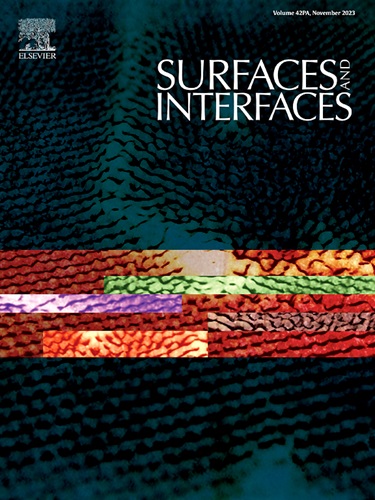Synergistic MXene/GO composites for flexible capacitive humidity sensors with ultrahigh sensitivity and fast response
IF 5.7
2区 材料科学
Q2 CHEMISTRY, PHYSICAL
引用次数: 0
Abstract
High-performance flexible humidity sensors are critical enabling components for next-generation wearable systems and electronic skin (e-skin), although achieving concomitant ultrathin geometries, mechanical flexibility, and ultrahigh sensitivity remains challenging. This study presents a significant advancement through the development of a capacitive flexible humidity sensor based on engineered Ti3C2Tx (MXene)/graphene oxide (GO) heterostructures. The synergistic interactions between the polar surface terminations of MXene (rich in –OH and –F groups) and the facilitated water transport properties of GO are exploited to yield a humidity-sensing layer exhibiting a significantly enhanced dielectric response to moisture. The optimized MXene/GO device achieves a striking ultrahigh sensitivity (S = 1.24 × 106 % ΔC/C₀), representing a 228-fold improvement over its pristine MXene counterpart, across a wide operational range of 11 % to 97 % relative humidity (RH). The sensor further exhibits rapid dynamic responses (adsorption/desorption times of 17 s / 7 s, respectively) and maintains excellent linearity (R2 = 0.99). This work highlights the efficacy of MXene/GO heterostructures for developing ultra-sensitive flexible humidity sensors, paving the way for innovative applications in non-contact interfaces, skin hydration diagnostics, and physiological monitoring.
协同MXene/GO复合材料用于超高灵敏度和快速响应的柔性电容式湿度传感器
高性能柔性湿度传感器是下一代可穿戴系统和电子皮肤(e-skin)的关键组件,尽管实现伴随的超薄几何形状、机械灵活性和超高灵敏度仍然具有挑战性。本研究通过开发一种基于工程Ti3C2Tx (MXene)/氧化石墨烯(GO)异质结构的电容式柔性湿度传感器取得了重大进展。MXene的极性表面末端(富含-OH和-F基团)与氧化石墨烯的易水输运特性之间的协同相互作用被利用来产生湿度传感层,该层对水分的介电响应显著增强。优化后的MXene/GO器件实现了惊人的超高灵敏度(S = 1.24 × 106% ΔC/C 0),在相对湿度(RH)为11%至97%的广泛工作范围内,比原始MXene器件提高了228倍。该传感器还表现出快速的动态响应(吸附/解吸时间分别为17 s / 7 s),并保持良好的线性(R2 = 0.99)。这项工作强调了MXene/GO异质结构在开发超灵敏柔性湿度传感器方面的功效,为非接触界面、皮肤水合诊断和生理监测方面的创新应用铺平了道路。
本文章由计算机程序翻译,如有差异,请以英文原文为准。
求助全文
约1分钟内获得全文
求助全文
来源期刊

Surfaces and Interfaces
Chemistry-General Chemistry
CiteScore
8.50
自引率
6.50%
发文量
753
审稿时长
35 days
期刊介绍:
The aim of the journal is to provide a respectful outlet for ''sound science'' papers in all research areas on surfaces and interfaces. We define sound science papers as papers that describe new and well-executed research, but that do not necessarily provide brand new insights or are merely a description of research results.
Surfaces and Interfaces publishes research papers in all fields of surface science which may not always find the right home on first submission to our Elsevier sister journals (Applied Surface, Surface and Coatings Technology, Thin Solid Films)
 求助内容:
求助内容: 应助结果提醒方式:
应助结果提醒方式:


